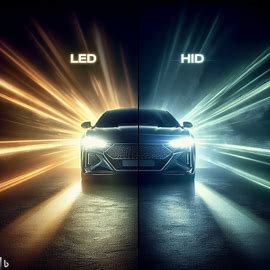In the automotive world, the debate between LED and HID headlights continues to intrigue vehicle owners seeking optimal lighting performance. With considerations such as brightness, lifespan, cost, and beam coverage, making an informed decision becomes imperative.
This article aims to provide a comprehensive overview of LED and HID headlights, delving into their advantages, installation procedures, and considerations for replacement. By examining the technical aspects and practical implications, readers will gain the knowledge necessary to confidently navigate the world of automotive lighting.
Brightness: Comparing the Luminosity of LED and HID Headlights
Comparing the luminosity of LED and HID headlights, it is important to consider the brightness level provided by each type of headlight.
HID headlights are known for their high brightness, surpassing the illumination provided by halogen bulbs. The use of metallic salts and a noble gas in HID headlights allows for a stronger and more intense light output.
On the other hand, LED headlights also offer significant brightness, providing enhanced visibility on the road. Although not as bright as HID headlights, LEDs still offer a substantial amount of luminosity. LED headlights are particularly praised for their ability to produce a focused and directed beam of light, illuminating the roadside with clarity.
Both types of headlights have their own advantages in terms of brightness, allowing drivers to choose the level of luminosity that best suits their needs.

Lifespan and Reliability: Analyzing the Durability and Consistency of LED and HID Headlights
LED and HID headlights offer different levels of lifespan and reliability. LED headlights have a longer lifespan compared to HID headlights, making them a more reliable choice for vehicle owners. LED headlights use a semiconductor to release photons and produce light, which results in a more stable and consistent performance. On the other hand, HID headlights use electrical interactions with metallic salts and a noble gas to generate light, which may not be as reliable over time.
Additionally, LED headlights produce less heat compared to HID headlights, further contributing to their durability and longevity.
Cost and Savings: Examining the Financial Implications and Long-Term Benefits of LED and HID Headlights
Analyzing the financial implications and long-term benefits of HID and LED headlights reveals the potential cost savings and advantages associated with each option. When considering the cost and savings of LED and HID headlights, it is important to take into account factors such as the initial purchase price, energy efficiency, and maintenance costs.
- LED headlights have a higher initial purchase price compared to HID headlights, but they are more energy efficient, resulting in lower long-term operating costs.
- HID headlights have a lower initial purchase price, but they consume more energy and require more frequent bulb replacements, increasing maintenance costs over time.
- LED headlights have a longer lifespan, reducing the need for frequent replacements and further contributing to cost savings.
Beam Coverage: Evaluating the Width and Reach of Light Provided by LED and HID Headlights
Given the varying beam coverage of LED and HID headlights, it is important to assess the width and reach of light provided by each option. HID headlights are known for producing a wider beam of light, which helps to illuminate a larger area on the road. This wide coverage can be beneficial in situations where there is a need to see a broader view of the surroundings.
On the other hand, LED headlights provide enhanced illumination of the roadside, allowing for better visibility of objects and potential hazards at the sides of the road. This focused beam can be particularly useful in urban areas or when navigating through curves and corners.
Ultimately, the choice between LED and HID headlights depends on individual preferences and driving conditions, as both options offer their own advantages in terms of beam coverage.
Glare and Heat: Addressing the Potential Issues of Glare and Heat Production With LED and HID Headlights
To fully comprehend the potential issues surrounding glare and heat production with both LED and HID headlights, it is imperative to thoroughly evaluate the impact of these factors on driver visibility and overall road safety.
Glare from headlights can be a major concern, as it can impair the vision of oncoming drivers and lead to accidents. LED headlights have an advantage in this aspect, as they produce less glare compared to HID headlights.
Additionally, heat production is another crucial factor to consider. HID headlights tend to generate more heat than LED headlights, which can pose a risk of damage to the headlight housing and surrounding components.
Installation and Replacement: Understanding the Process and Considerations for Installing or Replacing LED and HID Headlights
The installation and replacement of LED and HID headlights can be a complex process, but with careful consideration and following the provided instructions, it can be successfully completed. Before starting the installation process, it is important to understand how HID and LED headlights work and the factors to consider when choosing between them.
LED headlights are recommended for their brightness, ease of starting, and longevity, while HID headlights are known for their brightness and wider coverage area. When it comes to installation, it is crucial to carefully read and follow the instructions provided with the headlights. Different car models, brands, and years may require different installation procedures.
Many conversion kits are available as plug-and-play systems, making installation relatively easy. However, if unsure about the process, it is always best to seek professional assistance.
Conclusion
In conclusion, when comparing LED and HID headlights, it is important to consider factors such as brightness, lifespan, cost, beam coverage, glare, and heat production.
LED headlights offer increased longevity, energy efficiency, and enhanced roadside illumination.
HID headlights provide a brighter beam covering a wider area.
Ultimately, the choice between the two depends on individual preferences and specific lighting needs.
Both options have their advantages and considerations that should be taken into account when making a decision.

COMMENTS